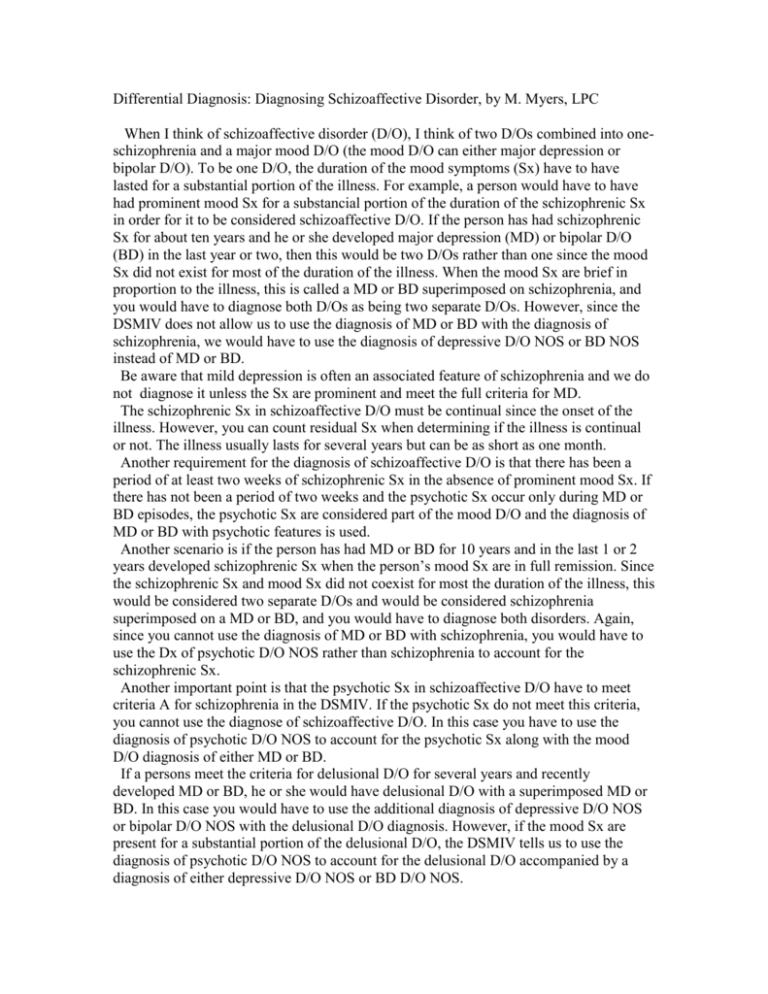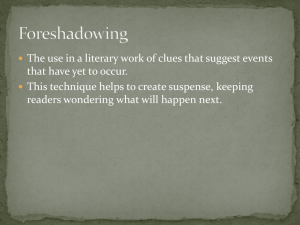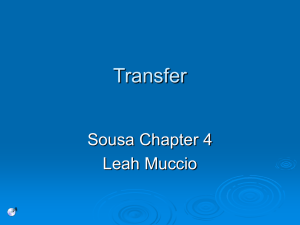Differential Diagnosis: Diagnosing Schizoaffective Disorder (D/O
advertisement

Differential Diagnosis: Diagnosing Schizoaffective Disorder, by M. Myers, LPC When I think of schizoaffective disorder (D/O), I think of two D/Os combined into oneschizophrenia and a major mood D/O (the mood D/O can either major depression or bipolar D/O). To be one D/O, the duration of the mood symptoms (Sx) have to have lasted for a substantial portion of the illness. For example, a person would have to have had prominent mood Sx for a substancial portion of the duration of the schizophrenic Sx in order for it to be considered schizoaffective D/O. If the person has had schizophrenic Sx for about ten years and he or she developed major depression (MD) or bipolar D/O (BD) in the last year or two, then this would be two D/Os rather than one since the mood Sx did not exist for most of the duration of the illness. When the mood Sx are brief in proportion to the illness, this is called a MD or BD superimposed on schizophrenia, and you would have to diagnose both D/Os as being two separate D/Os. However, since the DSMIV does not allow us to use the diagnosis of MD or BD with the diagnosis of schizophrenia, we would have to use the diagnosis of depressive D/O NOS or BD NOS instead of MD or BD. Be aware that mild depression is often an associated feature of schizophrenia and we do not diagnose it unless the Sx are prominent and meet the full criteria for MD. The schizophrenic Sx in schizoaffective D/O must be continual since the onset of the illness. However, you can count residual Sx when determining if the illness is continual or not. The illness usually lasts for several years but can be as short as one month. Another requirement for the diagnosis of schizoaffective D/O is that there has been a period of at least two weeks of schizophrenic Sx in the absence of prominent mood Sx. If there has not been a period of two weeks and the psychotic Sx occur only during MD or BD episodes, the psychotic Sx are considered part of the mood D/O and the diagnosis of MD or BD with psychotic features is used. Another scenario is if the person has had MD or BD for 10 years and in the last 1 or 2 years developed schizophrenic Sx when the person’s mood Sx are in full remission. Since the schizophrenic Sx and mood Sx did not coexist for most the duration of the illness, this would be considered two separate D/Os and would be considered schizophrenia superimposed on a MD or BD, and you would have to diagnose both disorders. Again, since you cannot use the diagnosis of MD or BD with schizophrenia, you would have to use the Dx of psychotic D/O NOS rather than schizophrenia to account for the schizophrenic Sx. Another important point is that the psychotic Sx in schizoaffective D/O have to meet criteria A for schizophrenia in the DSMIV. If the psychotic Sx do not meet this criteria, you cannot use the diagnose of schizoaffective D/O. In this case you have to use the diagnosis of psychotic D/O NOS to account for the psychotic Sx along with the mood D/O diagnosis of either MD or BD. If a persons meet the criteria for delusional D/O for several years and recently developed MD or BD, he or she would have delusional D/O with a superimposed MD or BD. In this case you would have to use the additional diagnosis of depressive D/O NOS or bipolar D/O NOS with the delusional D/O diagnosis. However, if the mood Sx are present for a substantial portion of the delusional D/O, the DSMIV tells us to use the diagnosis of psychotic D/O NOS to account for the delusional D/O accompanied by a diagnosis of either depressive D/O NOS or BD D/O NOS. In past issues of the newsletter I have written on Bipolar D/O vs Borderline PD, OCD vs OCPD, substance induced mental health Sx, and diagnosing persons with Sx of hallucinations, mania, anger, and panic attacks. If you feel that any of these articles might be helpful, you can email or call me and I will email you the article. If you have any questions concerning diagnosing, please don’t hesitate to ask me. I do not always know the answer, but I know where to look in the DSM to find it.






